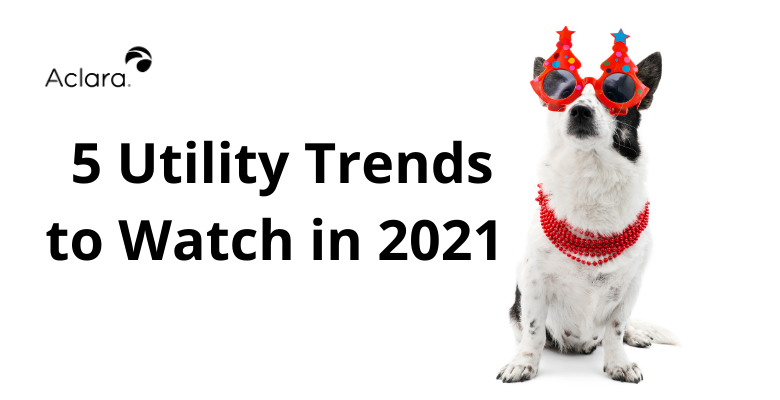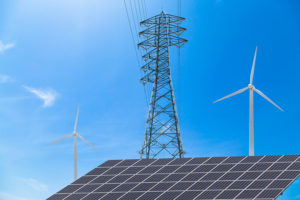 In 2020 utilities dealt with a worldwide pandemic, an intense wildfire season, and an unusually large number of hurricanes and weather events. Utilities also coped with market and technology changes driven by factors such as an upsurge of renewables on the grid, modifications in demand for resources, and increased environmental requirements, among others. What will 2021 hold? These 5 trends suggest utilities will recover from challenges related to COVID-19, make progress on energy-efficiency programs, improve analytics, step up plans to integrate renewables into the grid and develop better strategies for wildfire management.
In 2020 utilities dealt with a worldwide pandemic, an intense wildfire season, and an unusually large number of hurricanes and weather events. Utilities also coped with market and technology changes driven by factors such as an upsurge of renewables on the grid, modifications in demand for resources, and increased environmental requirements, among others. What will 2021 hold? These 5 trends suggest utilities will recover from challenges related to COVID-19, make progress on energy-efficiency programs, improve analytics, step up plans to integrate renewables into the grid and develop better strategies for wildfire management.
Keep up with utility trends. Subscribe to our blog.
1: Energy efficiency takes center stage
Energy efficiency programs to reduce carbon emissions will take center stage at utilities in 2021, with a recent rash of utilities including Southern Company, Xcel Energy, Duke Energy, Dominion Energy, Arizona Public Service, NRG, PSEG, and Consumers Energy committing recently to net-zero carbon goals. Today, the NRDC (Natural Resources Defense Council) reports that half the nation’s population is now served by utilities committed to full decarbonization. In addition, state governments and local organizations will push energy efficiency efforts. Energy efficiency combined with building electrification, for example, will provide a third of the emissions reductions needed for New York to achieve a reduction in carbon emissions of 40% by 2030. Efforts by organizations such as NRDC, which recently worked with the Michigan Energy Efficiency for All coalition to help create energy efficiency portfolios for Consumers Energy and DTE, will continue.
2: Utilities turn to analytics and digital twins
Digital twins are virtual models that simulate utility infrastructure and processes, allowing utilities to investigate solutions to problems. According to an article by the Utility Analytics Institute, “they can live in the cloud, and significantly reduce costs and risks associated with construction, maintenance, and performance optimization strategies.” The City of San Diego, for example, is using a digital twin of the advanced water purification facility to improve commissioning and long-term operations as an operator training platform as part of its Pure Water San Diego program, which will supply one-third of the city’s water by 2035.
They [digital twins]can live in the cloud, and significantly reduce costs and risks associated with construction, maintenance, and performance optimization strategies.
Utility Analytics Institute
Data from advanced metering infrastructure (AMI) solutions and the analytics it enables feed these models, maximizing the value of utility data. In the water industry, for example, AMI and sensors that send data back over the AMI network give the digital twin an accurate snapshot of how much water flowed and the state of pressure in the pipes.
3: Recovering from a worldwide pandemic
New technologies will help utilities deal with the unexpected challenges caused by the COVID-19 pandemic. Many of these technologies will involve managing remote workforces as well as remote workplaces, according to Deloitte. When managing a remote workforce, real-time data is necessary for success. This means utilities need comprehensive workforce management solutions that can handle staffing, warehousing, hiring and training of personnel, reverse logistics. Utilities will continue to rethink processes because worldwide demand patterns changed significantly with the pandemic. Retail energy use went up, while commercial use declined. While these changes may or may not be permanent, utilities need to understand the patterns and react to them. According to a recent report by OMDIA, utilities may find solutions surrounding their COVID-19 concerns in the existing AMI software and services technology they already have. Analytics can help utilities gain visibility into operations and maximize the value of their smart-grid data by using it to improve processes.
4: Renewables lead generation projects
Renewables will outpace coal and gas-powered generation projects in 2021 and beyond, according to Industrial Info Resources. The government’s Energy Information Agency expects the electric power sector to add 32.5 gigawatts (GW) of wind capacity and 26.8 GW of solar by the end of 2021.  While this is good news for carbon emissions, renewables make it immensely more difficult for utilities to match supply and demand. Unlike traditional coal and gas-powered plants, which can provide power on a schedule depending on demand, renewables generate only when the wind is blowing or the sun shines. What’s more, so-called “behind the meter” distributed energy resources (DERs) like home solar panels can also cause problems on a grid originally designed for one-way power flow from a central source. If power generated from home-based DERs flows back onto the grid, voltages may increase, which can trip protective devices and cause outages. Distribution automation solutions that employ devices such as load tap changers, reclosers, and capacitor banks, and smart inverters can bridge the gap between SCADA systems, outage management, and advanced metering when it comes to managing the effect of DERs on the grid.
While this is good news for carbon emissions, renewables make it immensely more difficult for utilities to match supply and demand. Unlike traditional coal and gas-powered plants, which can provide power on a schedule depending on demand, renewables generate only when the wind is blowing or the sun shines. What’s more, so-called “behind the meter” distributed energy resources (DERs) like home solar panels can also cause problems on a grid originally designed for one-way power flow from a central source. If power generated from home-based DERs flows back onto the grid, voltages may increase, which can trip protective devices and cause outages. Distribution automation solutions that employ devices such as load tap changers, reclosers, and capacitor banks, and smart inverters can bridge the gap between SCADA systems, outage management, and advanced metering when it comes to managing the effect of DERs on the grid.
5: New strategies for wildfire management
In addition to a global pandemic, utilities had to deal with a particularly brutal fire season in 2020. The summer of 2020, for example, brought apocalyptic fires raging in Oregon and California. And the world could only watch as Australia’s awful fire season charred more than 12.4 million acres, killed more than 30 people, and left millions of animals either dead, injured, displaced, or struggling to survive in scorched habitats. In 2021, utilities will continue to look for creative ways to anticipate problems that could spark wildfires. Vegetation management, for example, is a significant wildfire mitigation effort for most utilities. One method used for vegetation management analyzes data from advanced metering infrastructure systems looking for momentary outages that could indicate vegetation contact with wires. In remote areas, grid monitoring with smart grid sensors, according to a Utility Dive piece, is filling an important niche in the fight against wildfires. This is one reason why Pacific Gas & Electric told California told regulators it would be using them to help manage its network. Wildfires are caused by a myriad of additional factors including lightning strikes, human error, and faulty equipment, but wildlife contact with electrical equipment also poses an ignition risk. Reducing animal contact with wires and utility equipment also diminishes the chances of wildfires.



